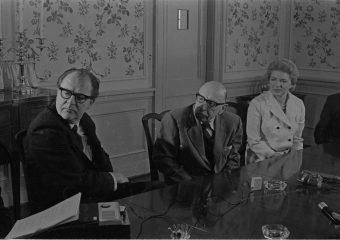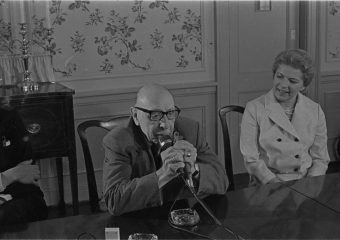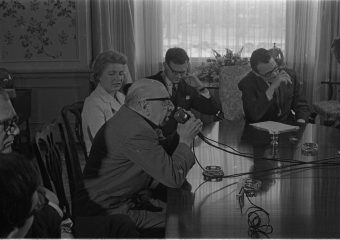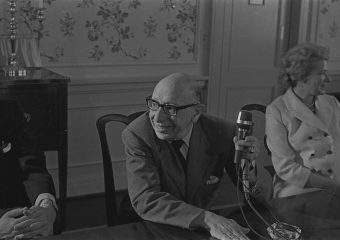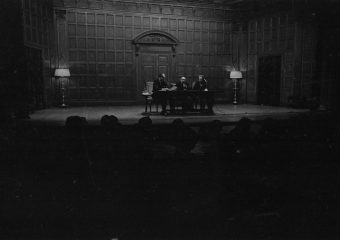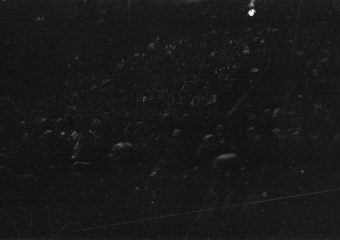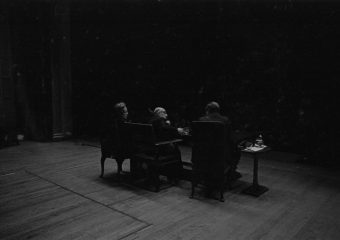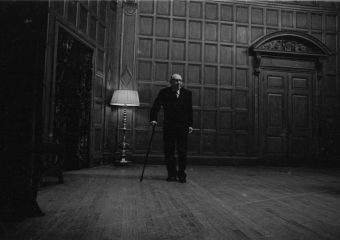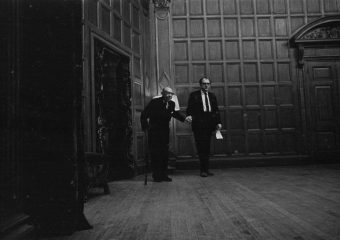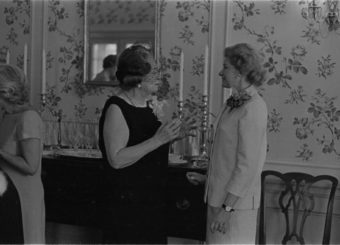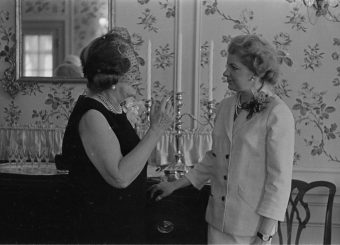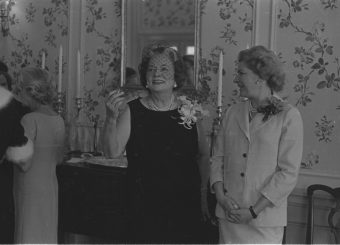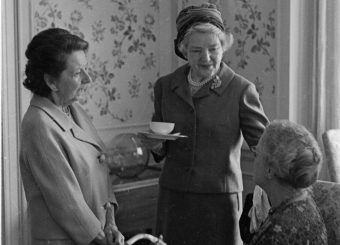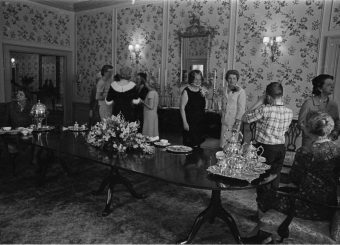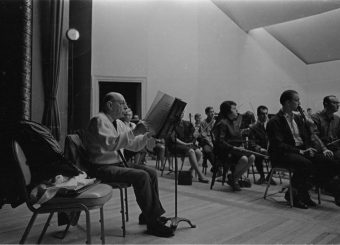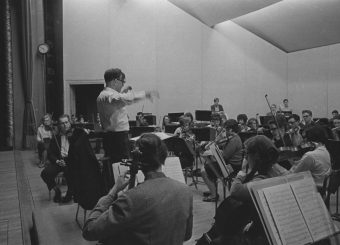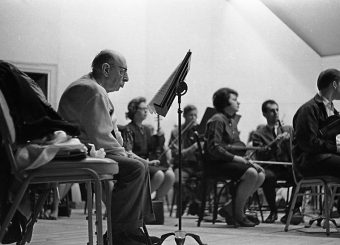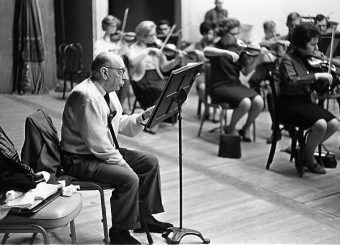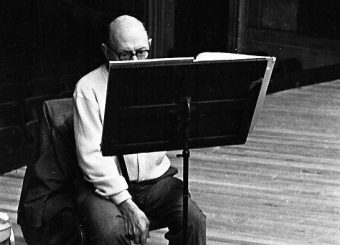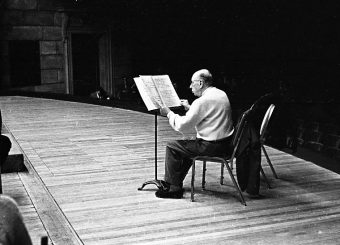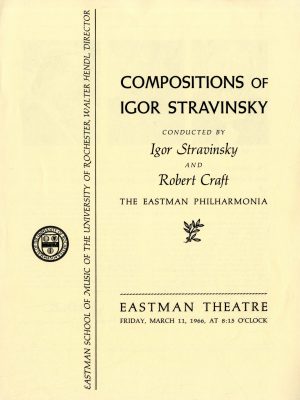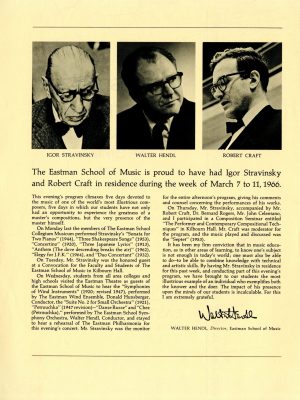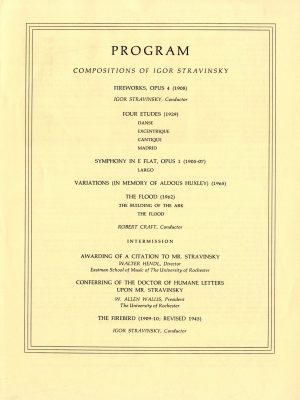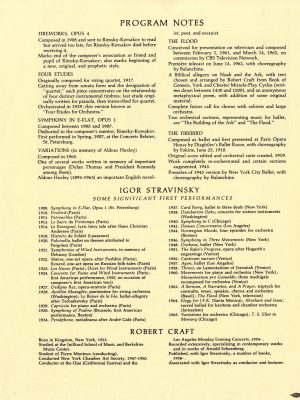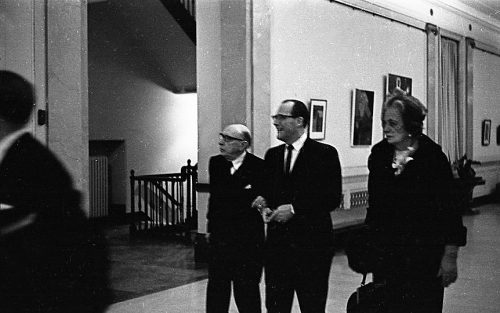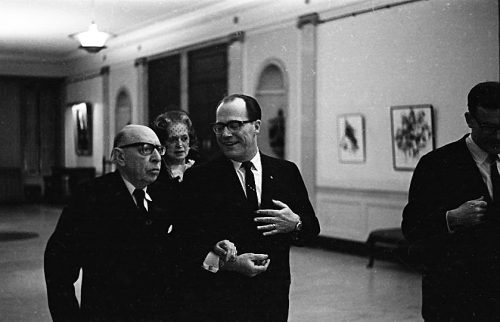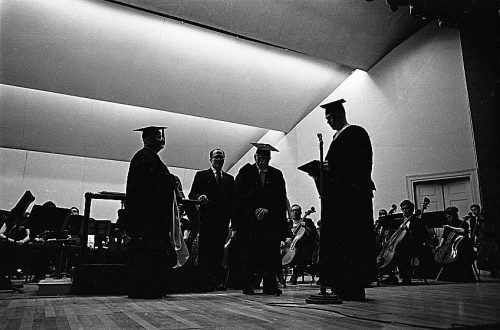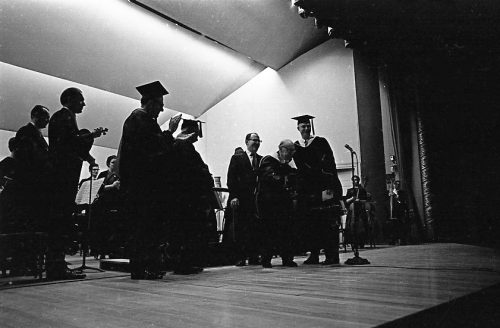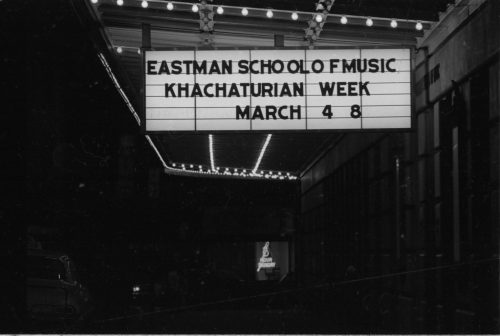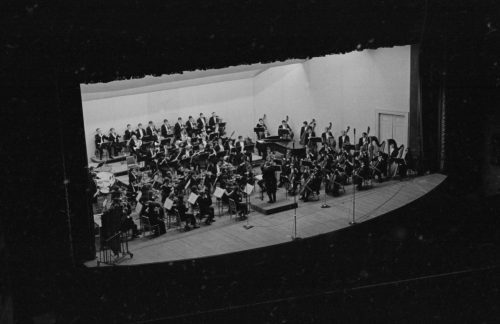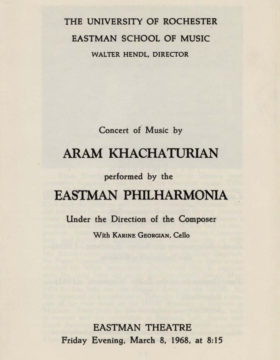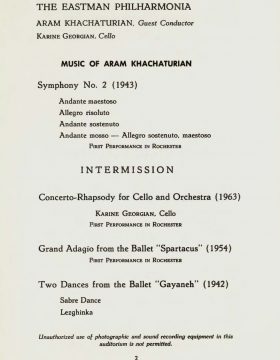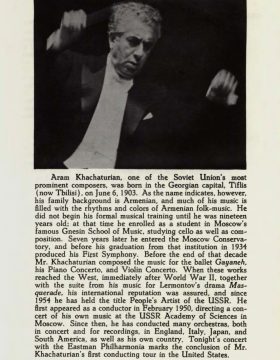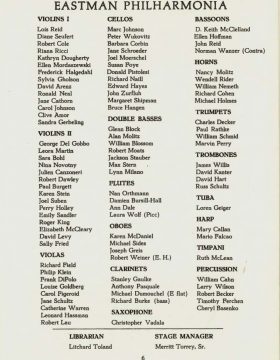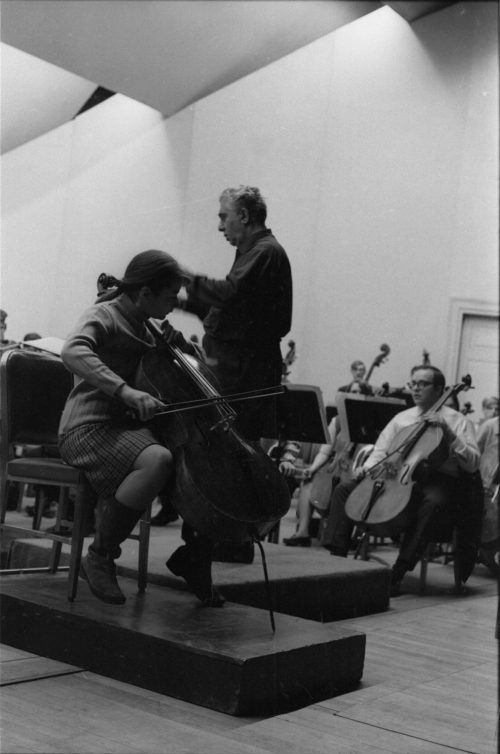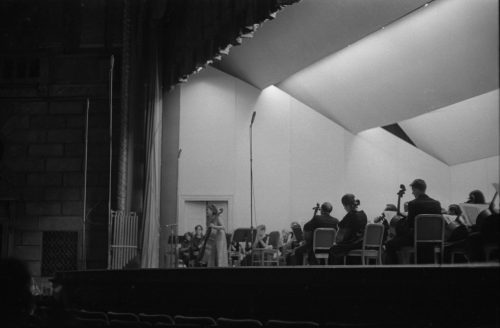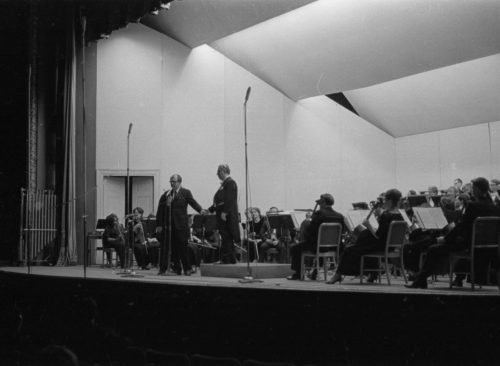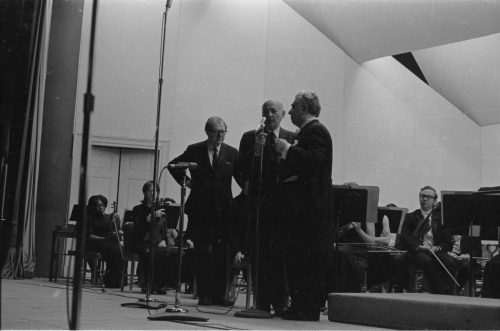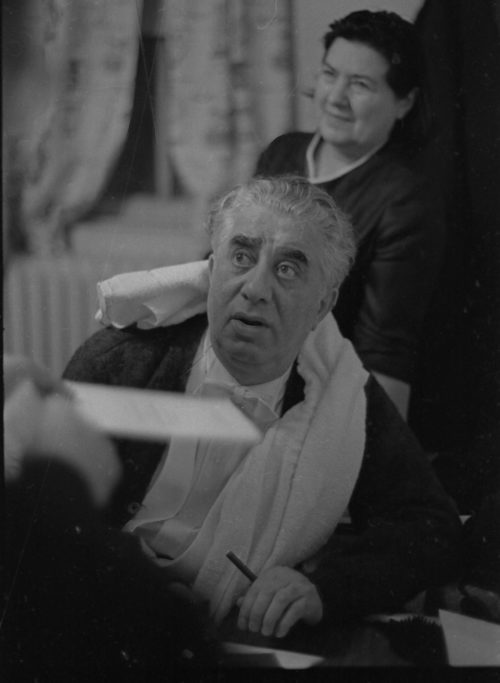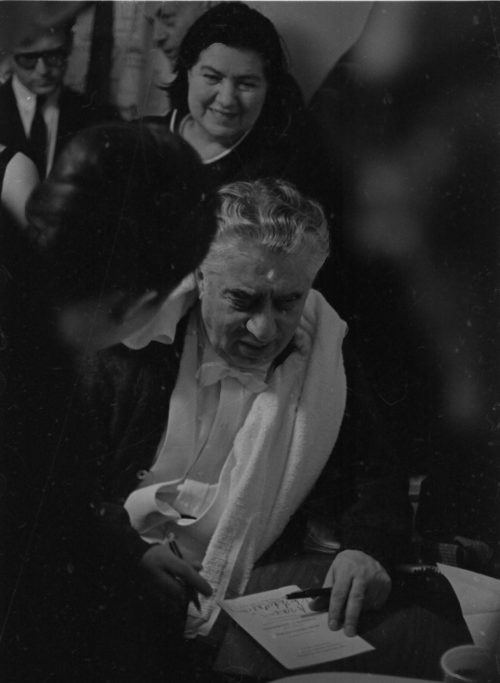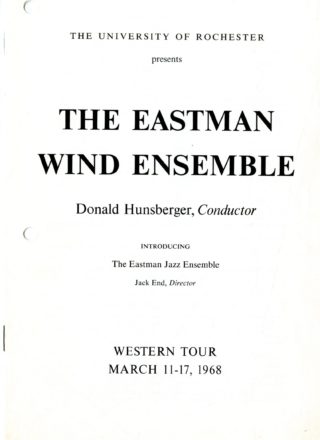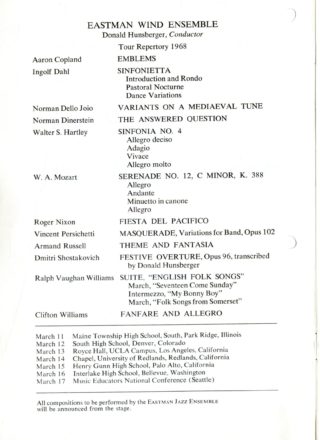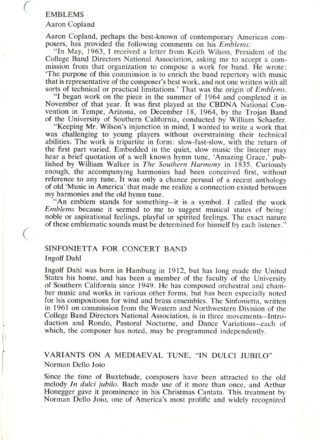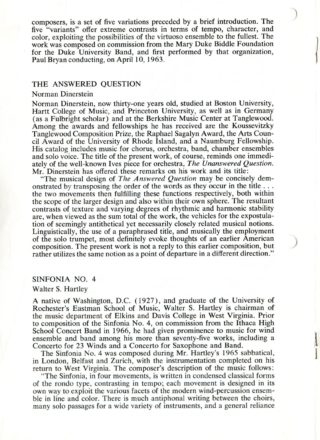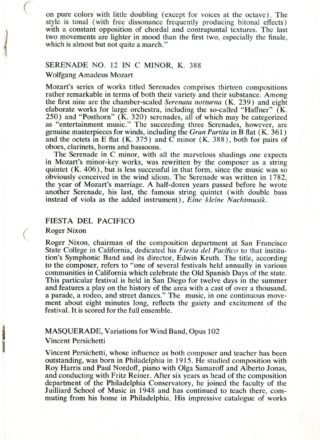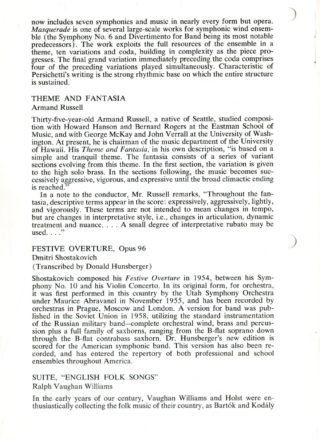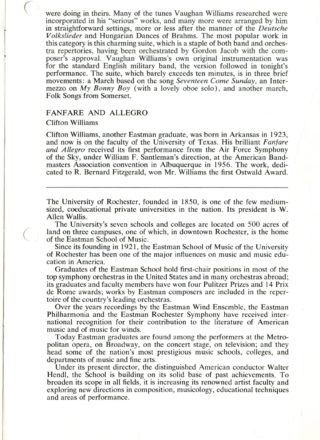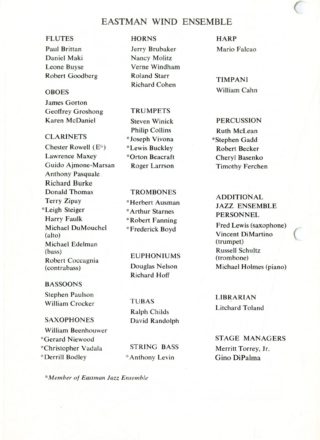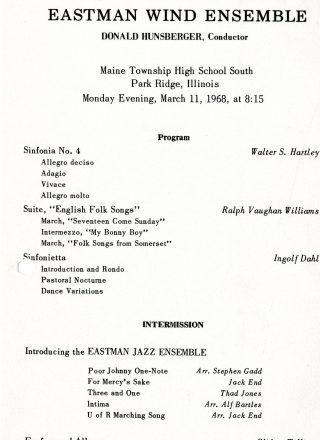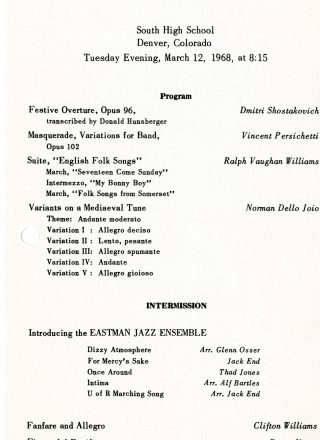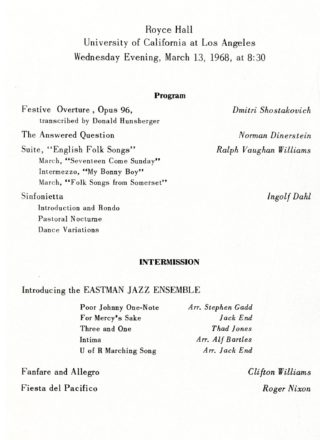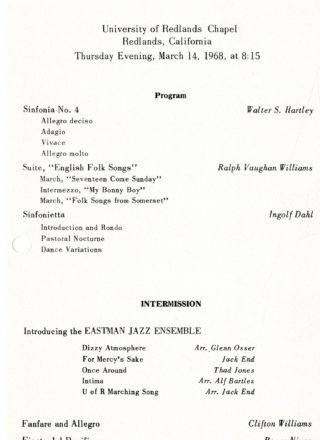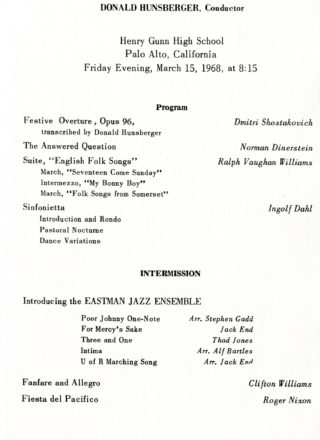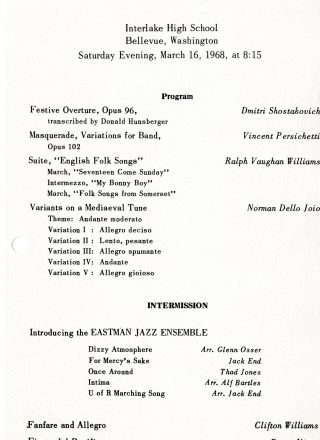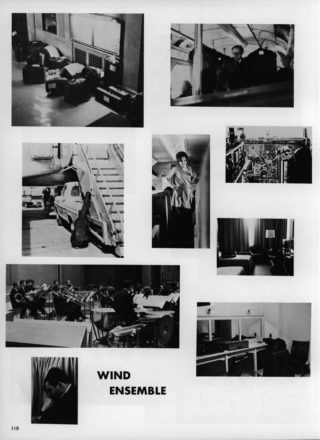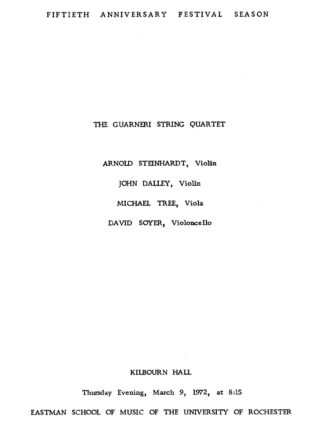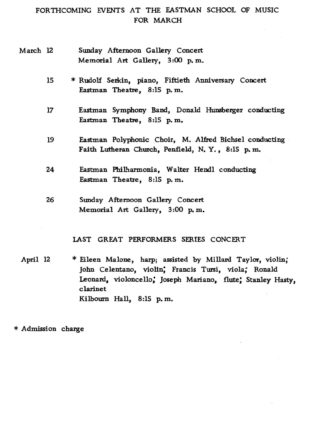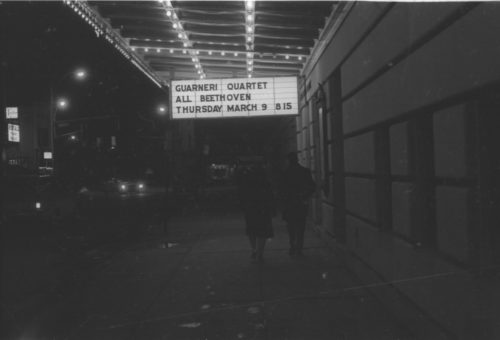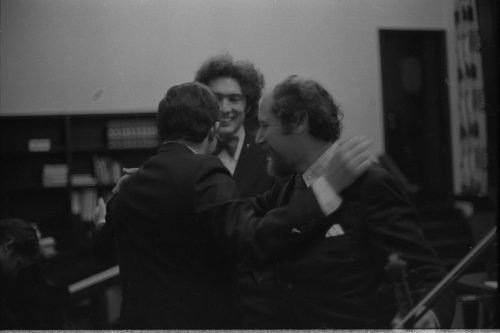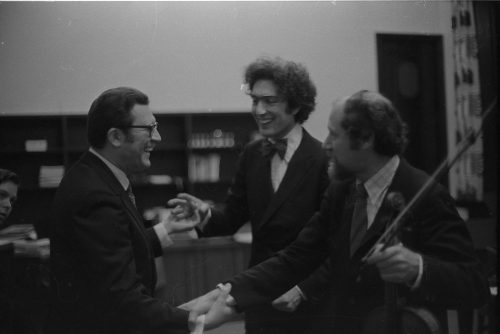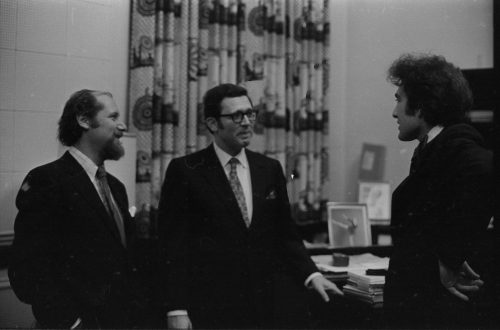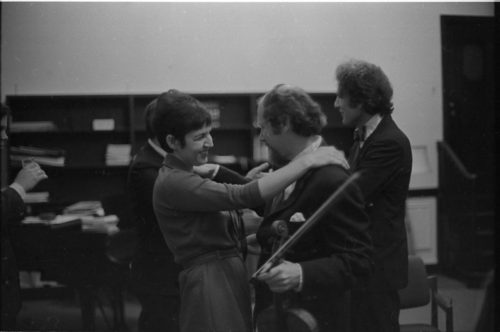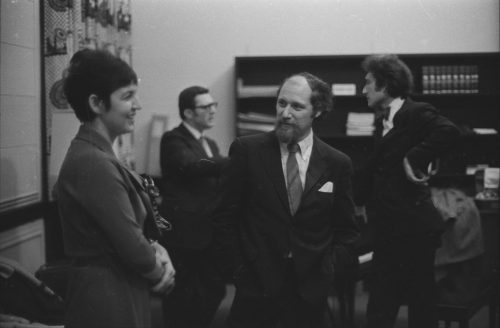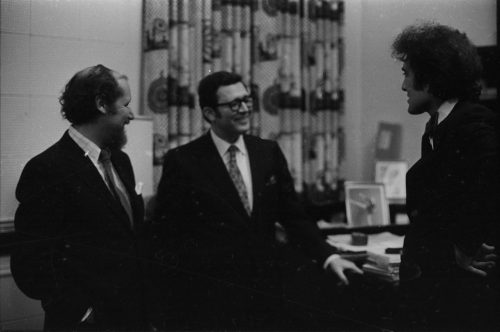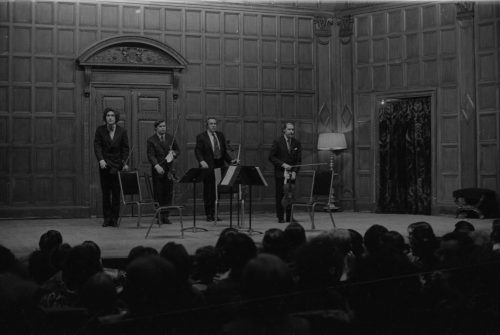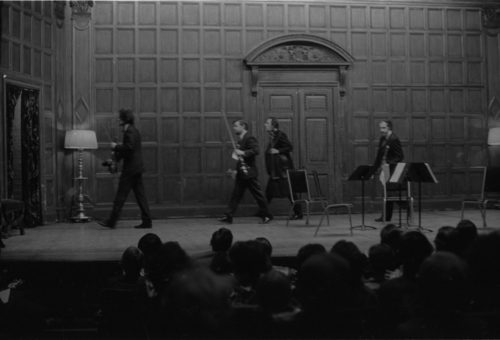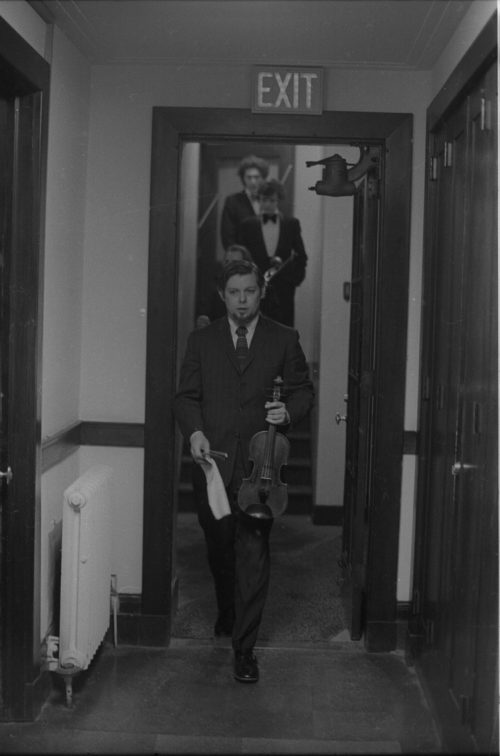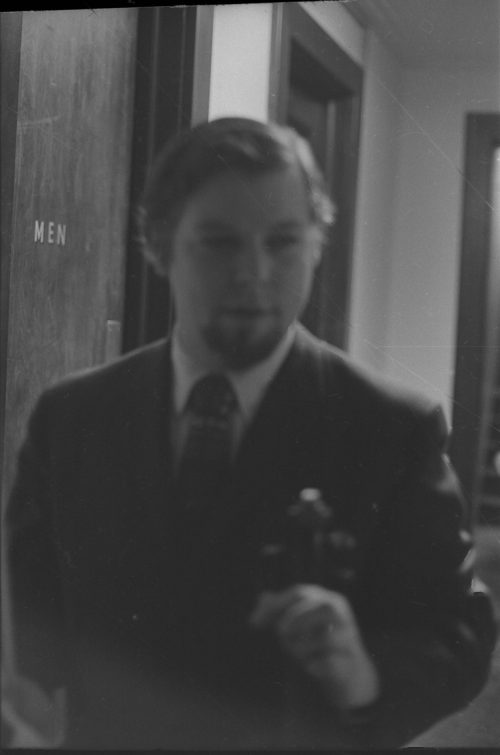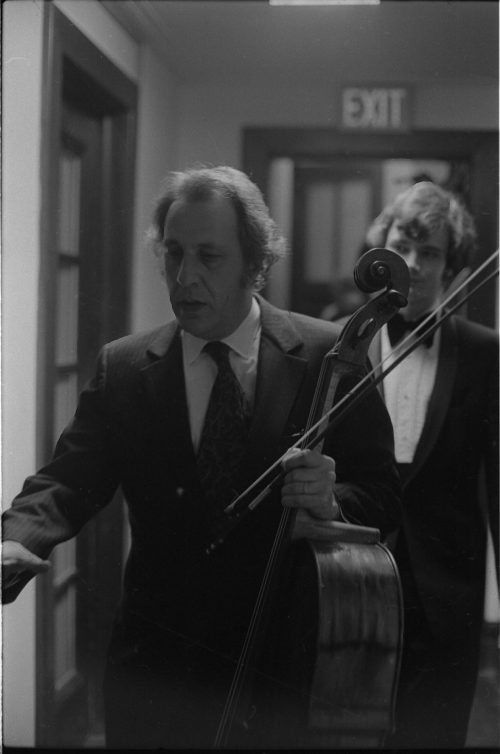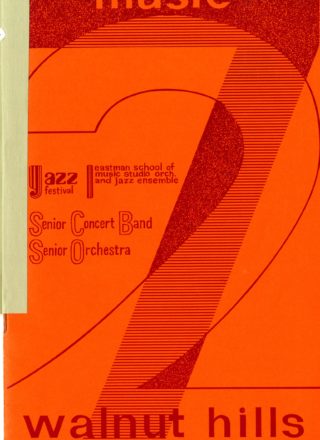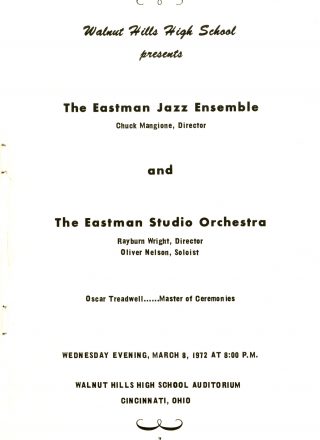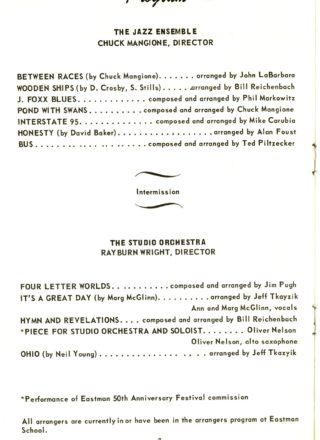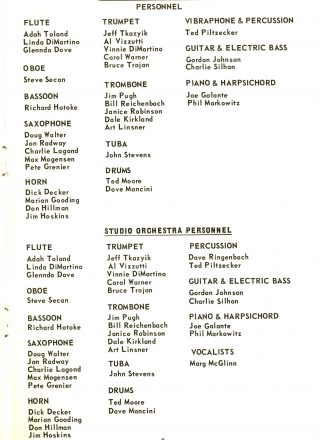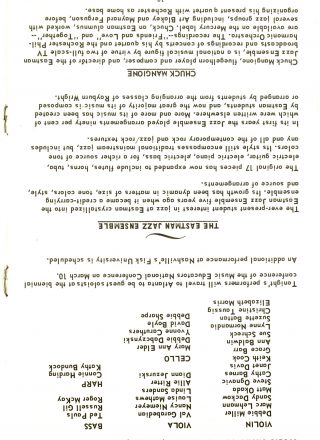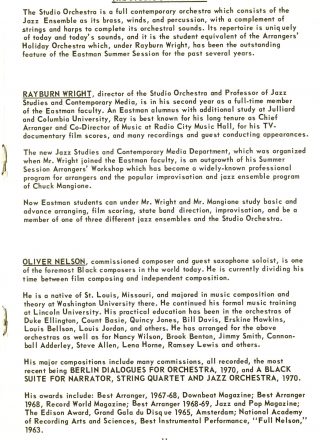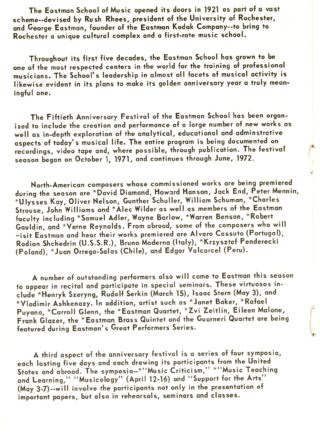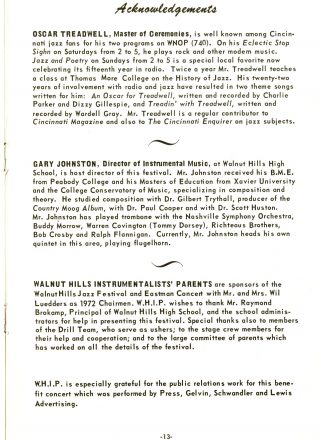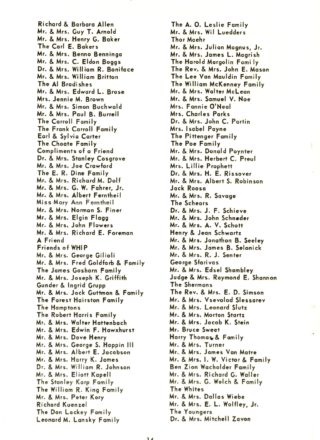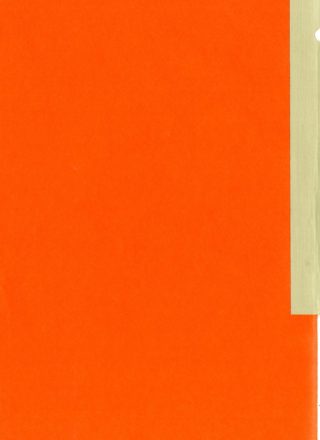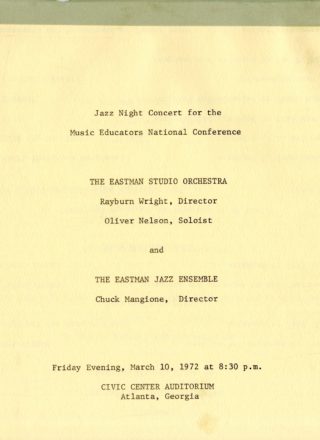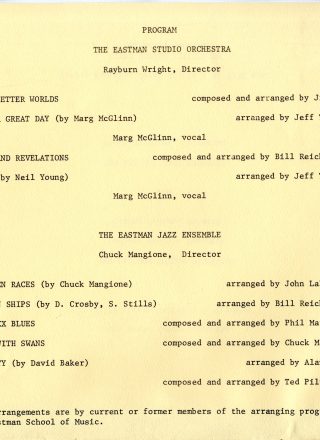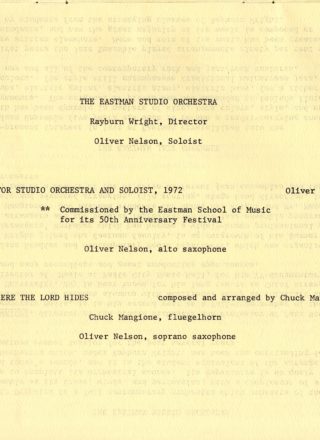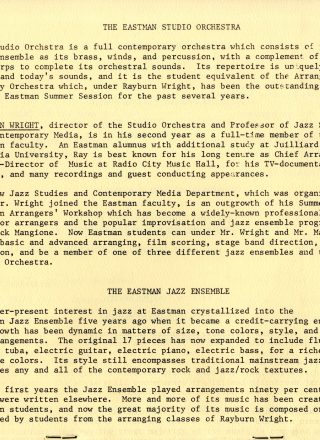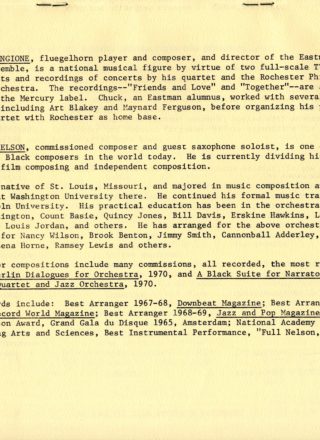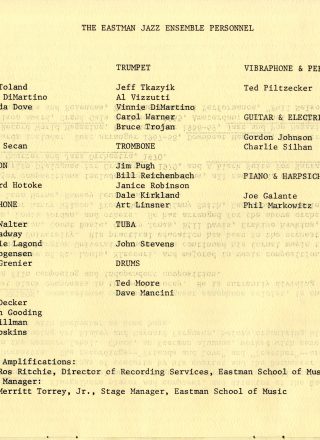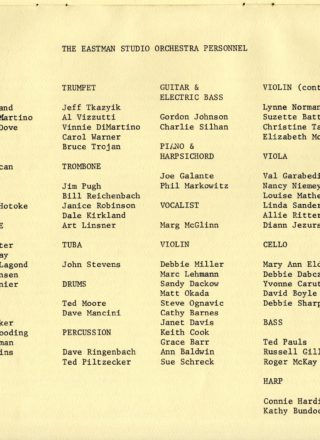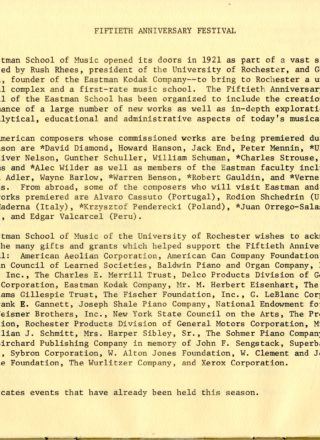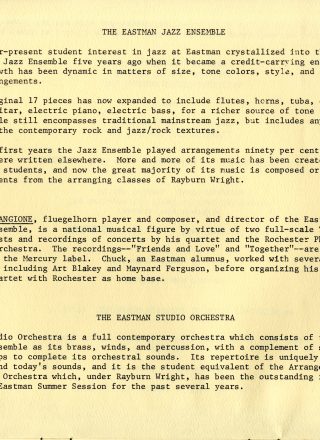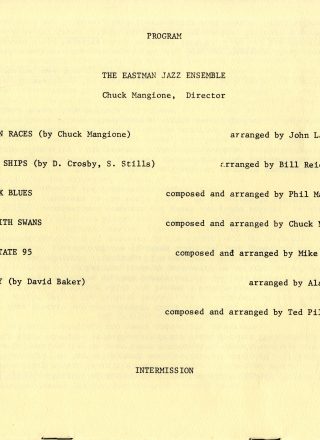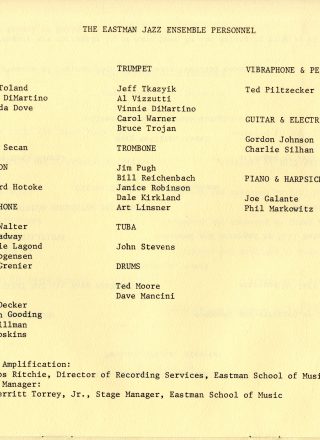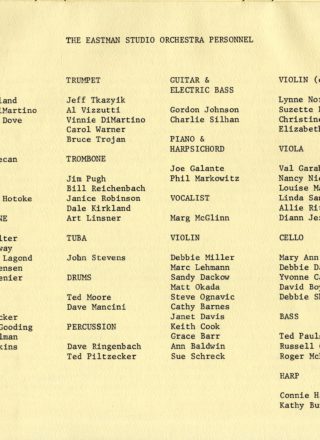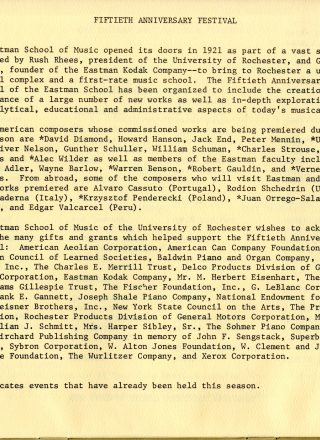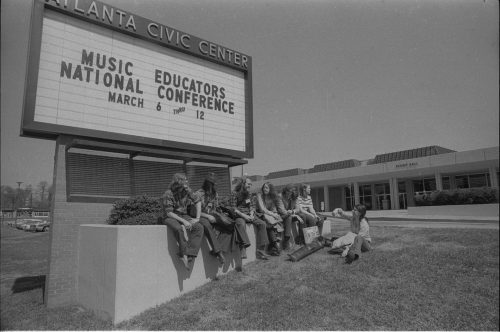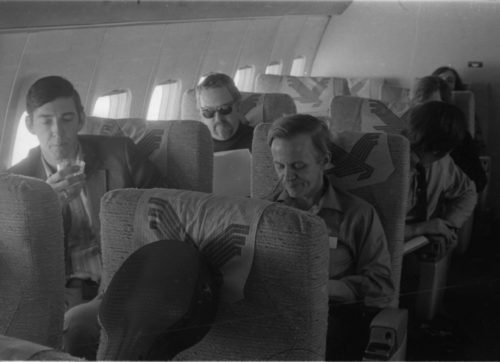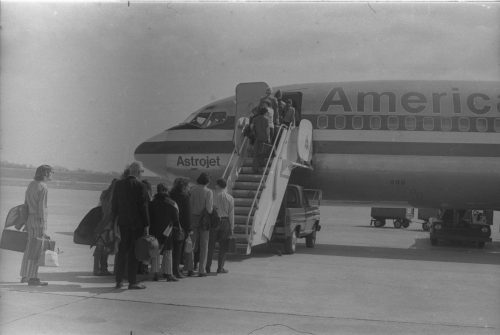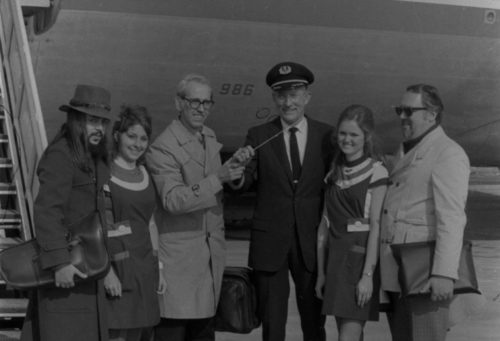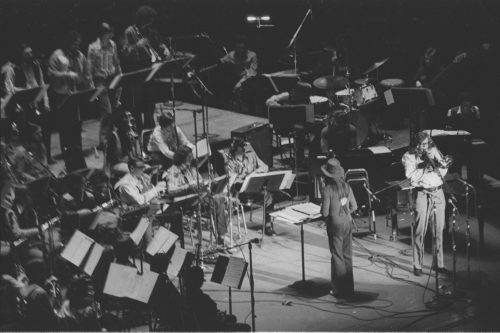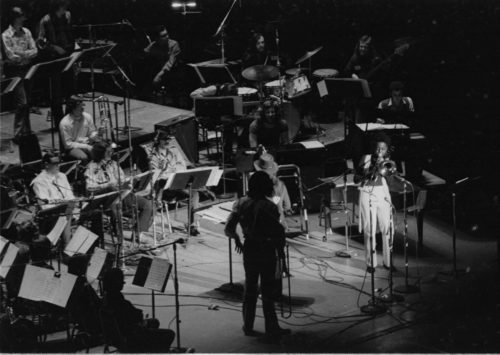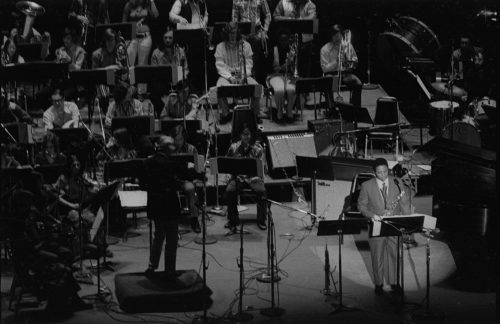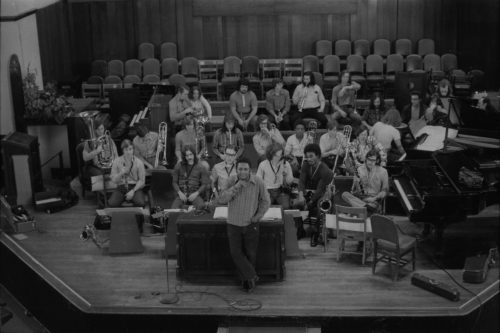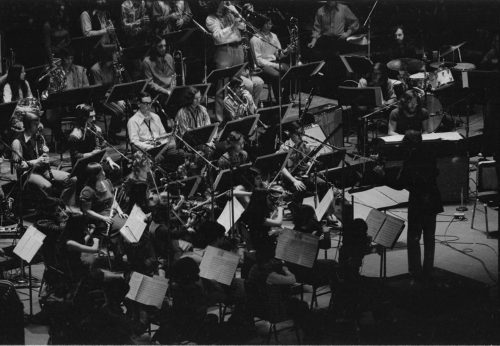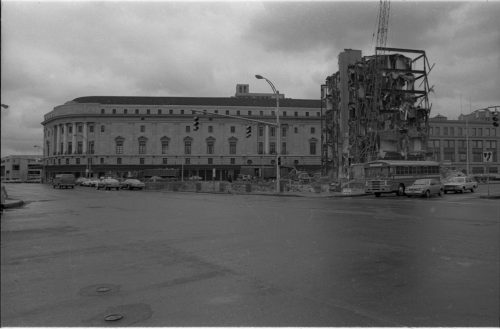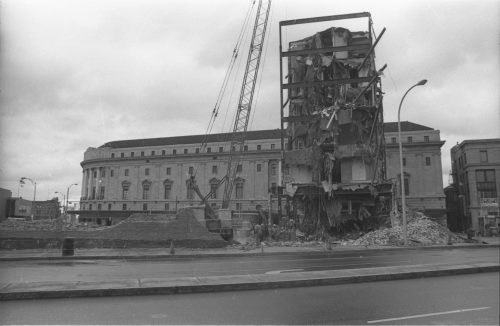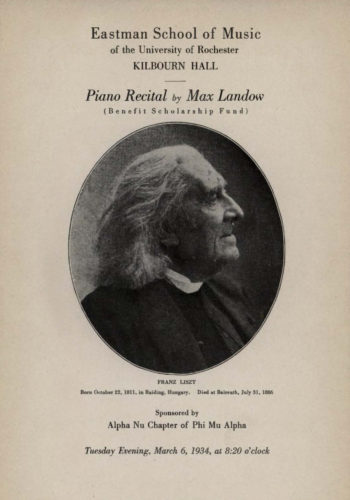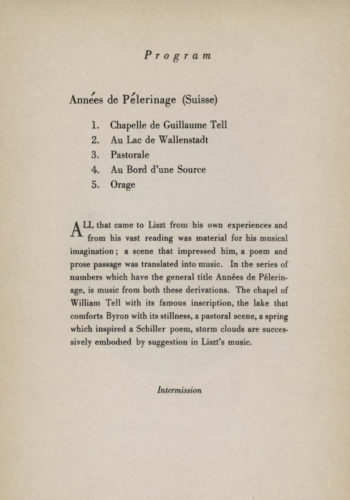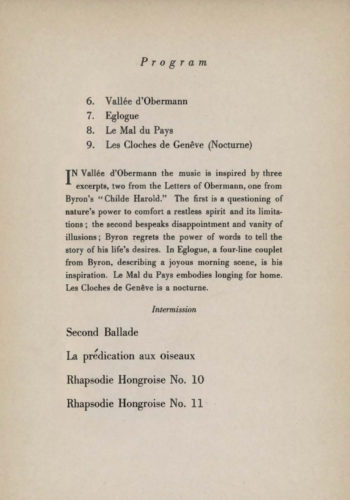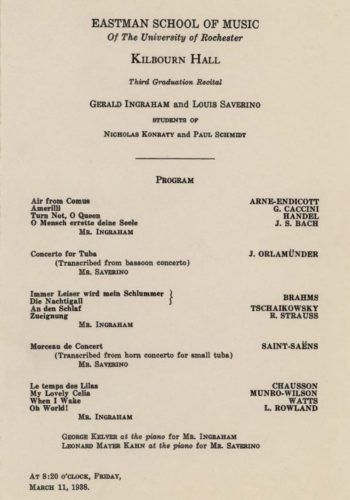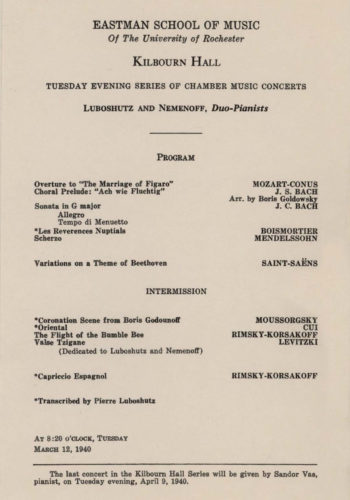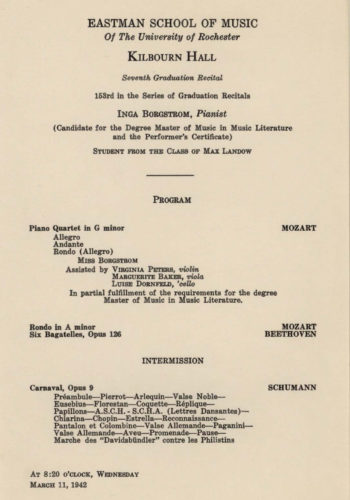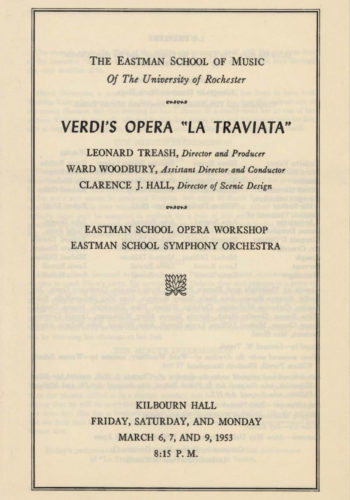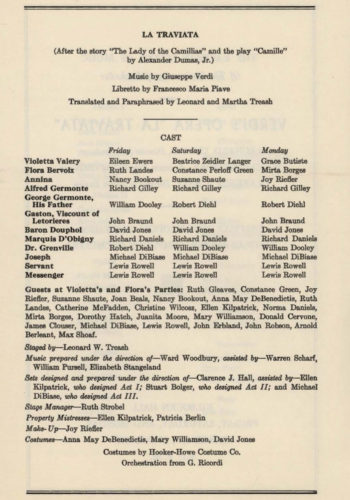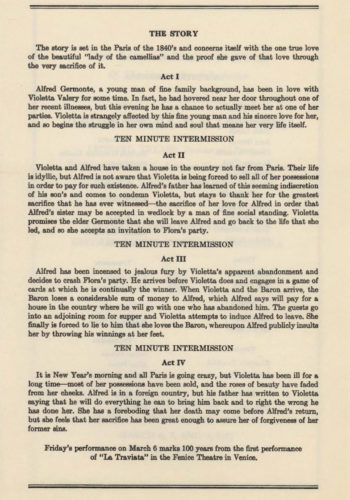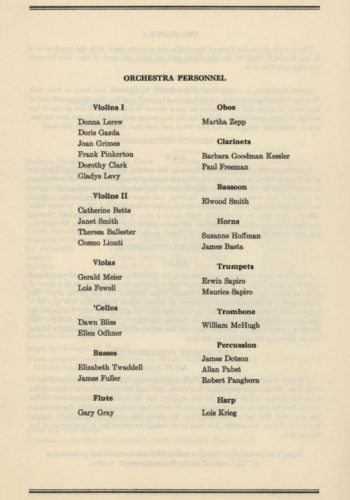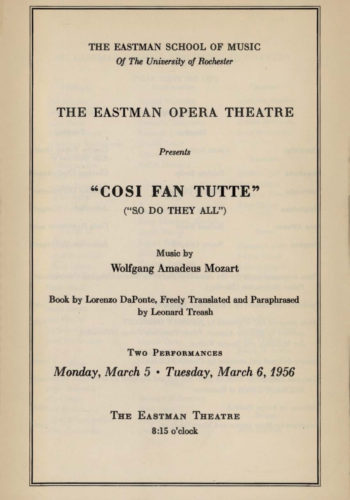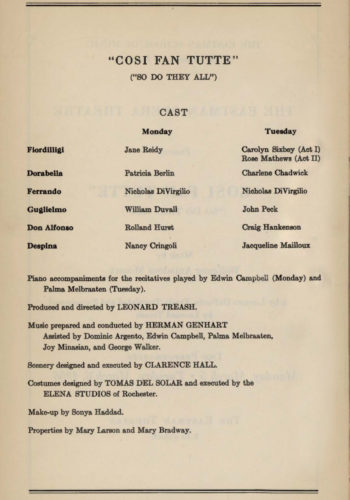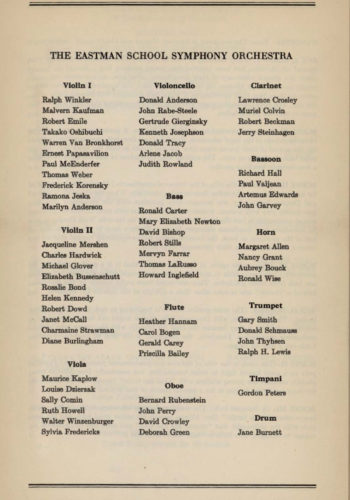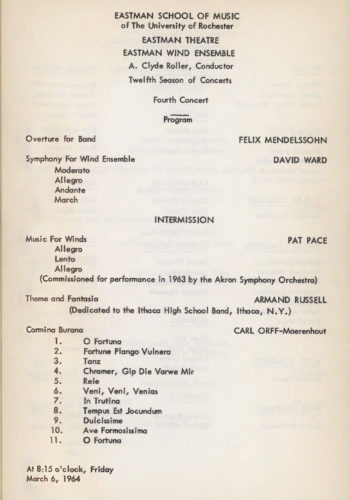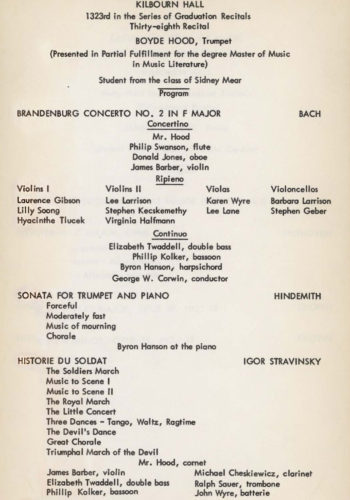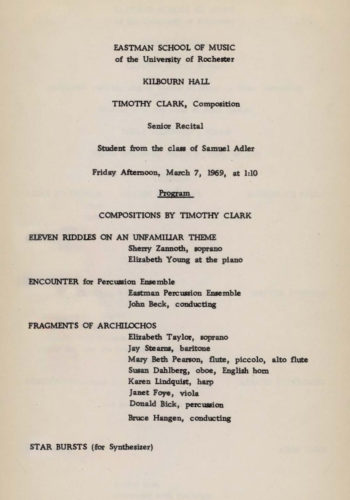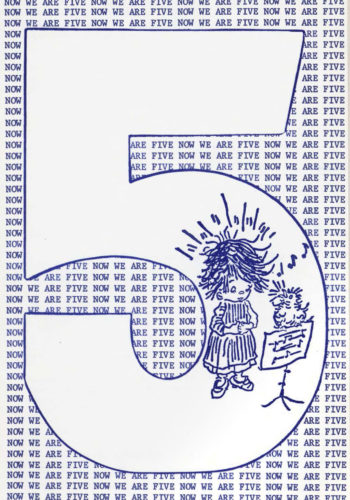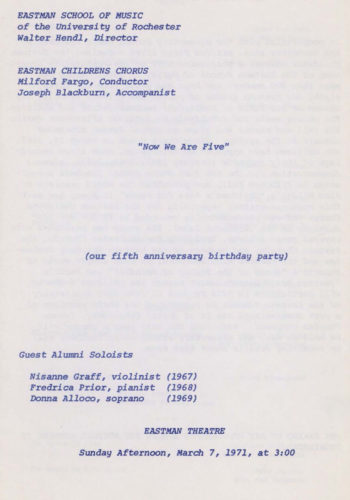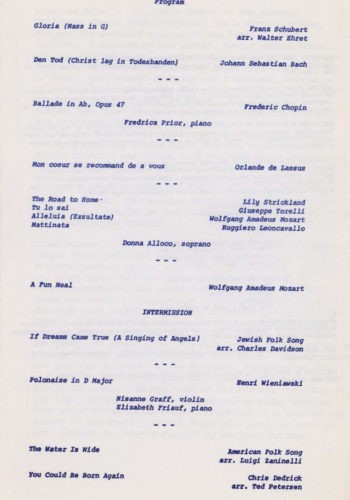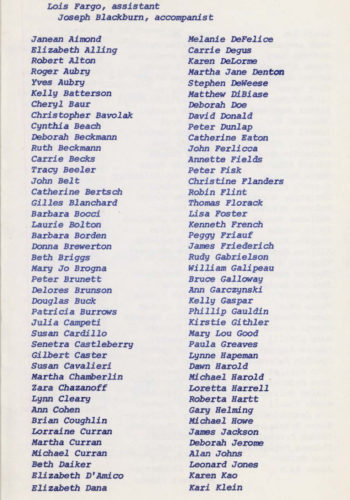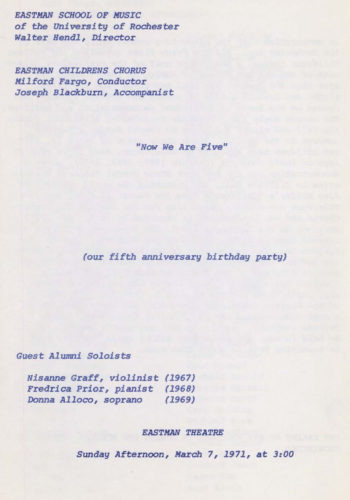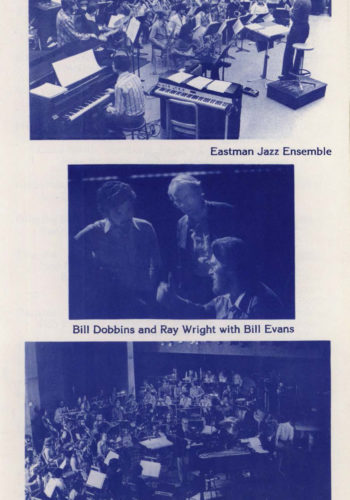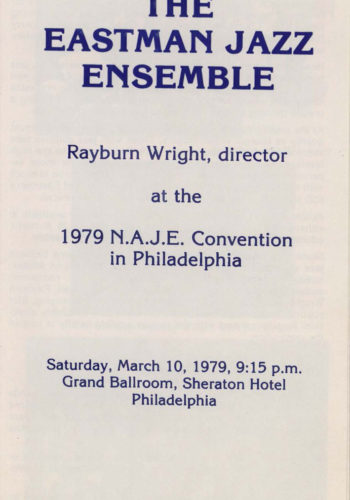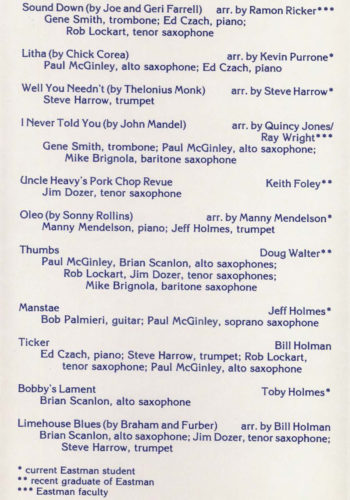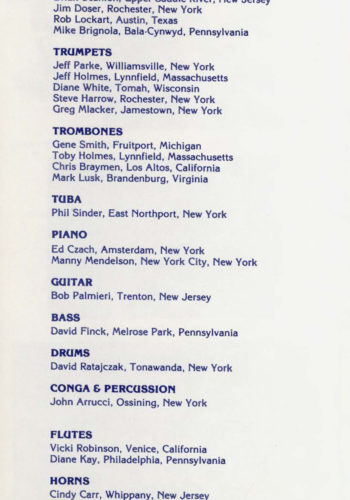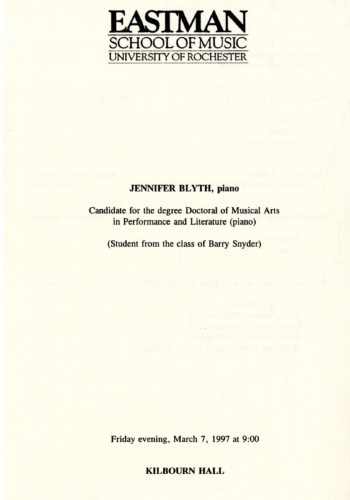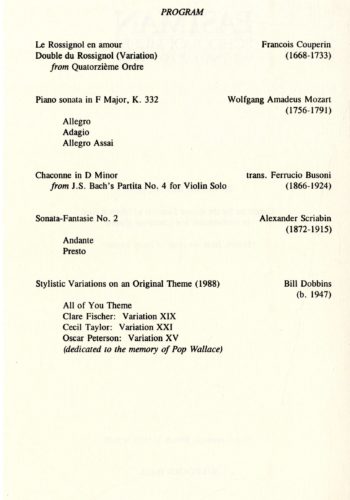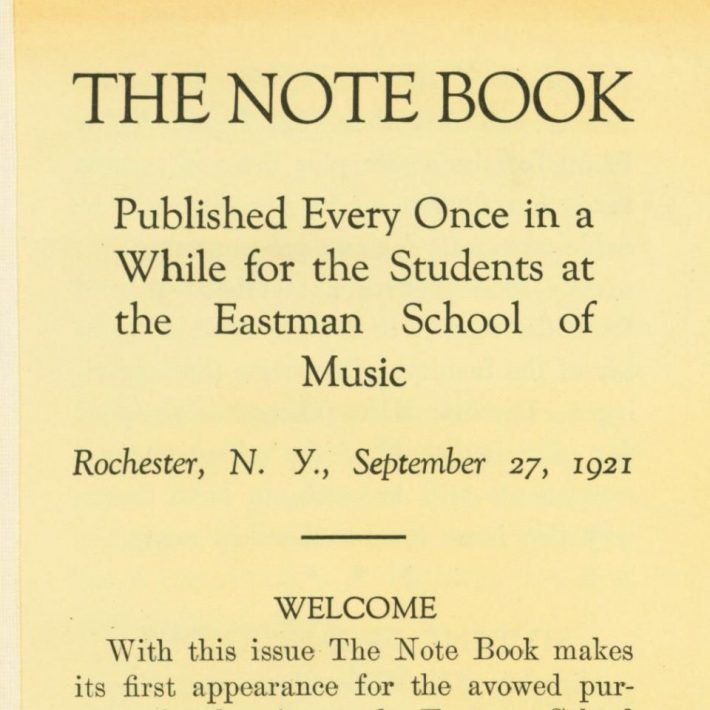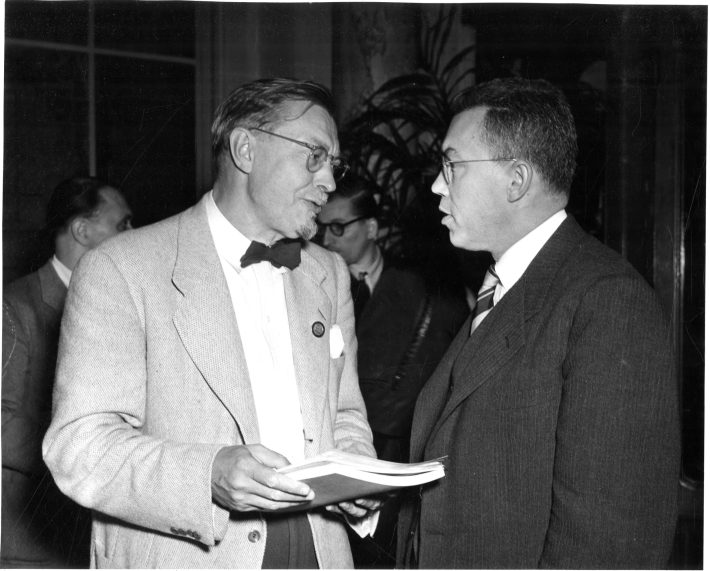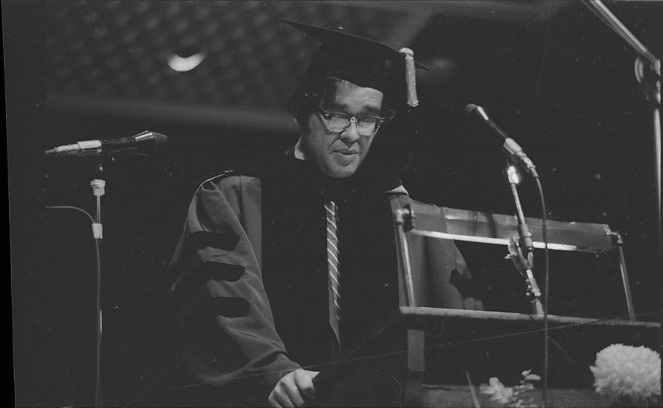Published on March 7th, 2022
1966: “Stravinsky Week” at Eastman
Fifty six years ago this week, five days in March, 1966 were officially known as “Stravinsky Week” at the Eastman School of Music, when composer Igor Stravinsky (1882-1971) was in residence by invitation of Director Walter Hendl, who had known the composer personally for numerous years.[1] Mr. Hendl later described having conceived the Stravinsky residency “with a view toward bringing Eastman students into direct contact with the outstanding factors in today’s musical world” and he continued, “I have always felt there is real value in any encounter with a creative force. The phenomenon that is Stravinsky, of course, is entirely unique, and this was quite an encounter.”[2] To that end, the week’s events were designed to enable quality interaction between composer and Eastman School community in meaningful ways. Professor Donald Hunsberger, then-chairman of the Eastman School Ensembles department, was chairman of the special Stravinsky Week Committee, the other members of which were Professors Charles Warren Fox, George Corwin, and Robert Gauldin. The week would conclude with a gala concert at which the University would confer an honorary doctorate on the composer.
All-media conference at Hutchison House on Monday, March 7th, 1966. Igor Stravinsky is flanked by Eastman School Director Walter Hendl and Mrs. Edith Hendl. Mr. Stravinsky’s assistant, composer Robert Craft, is also present. R63-12A, R63-13A, R63-14A, R63-16A, R63-21A, R63-35A (6)
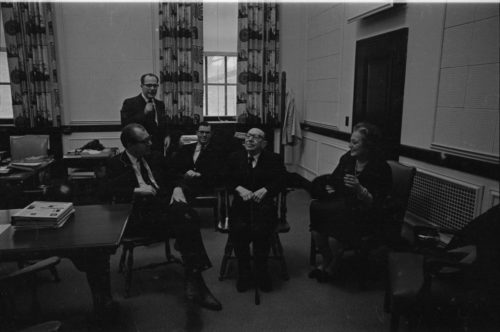
Visitation for faculty members and students on Tuesday, March 8th, 1966. Igor and Vera Stravinsky are joined on the stage of Kilbourn Hall by Walter Hendl. R68-6, R68-8, R68-10, R68-18, R68-21 (5)
It has frequently been said around the Eastman School that the Stravinsky residency represented another step in the Hendl Administration’s embrace of the musical world beyond American music. Throughout Howard Hanson’s long tenure, the Eastman School of Music had correctly been perceived as an institution where American music and the American composer were ardently championed. The many American Composers’ Concerts, and the annual Festivals of American Music (1931-1971) bore testimony to this. I myself have quipped more than once that during the Hanson years, one might appropriately have draped a banner reading “American music played here” on the Eastman School’s exterior. The cause of American music was a valid and worthy mission, and its advocacy at the Eastman School did not end with Hanson’s retirement. For one thing, the Festivals of American Music continued through 1971 with Hanson’s continuing administrative participation, and still today, the Howard Hanson Institute for American Music is instrumental in the commissioning of new works. The difference between the Hanson era and later is one of priority, or of balance; in the post-Hanson Eastman School, American music has taken its place as one creative entity within a broader vision of music. Under Director Hendl’s leadership there came a succession of high-profile events which brought the students and faculty of the Eastman School into direct contact with noteworthy international figures. The first had been in December, 1965 when Mr. Hendl had conducted the Western Hemisphere premiere of Dmitri Kabalevsky’s Requiem, opus 27 in a performance featuring a children’s chorus drawn from the Rochester City School District. (That same chorus would be re-branded the following year as the Eastman Children’s Chorus, and would remain active through the 1970s.) Roll forward to March, 1966, when a major composer would be in residency.
During the Eastman School’s Stravinsky Week, Mrs. Edith Hendl hosts a tea at Hutchison House in honor of Mrs. Vera Stravinsky. (Hutchison House, 930 East Avenue, was the official residence of the Eastman School Director for a period of several years.) Other guests included Professor Cecile Staub Genhart and Dean of Students Flora Burton, both of whom are captured in one of these shots. R64-9A, R64-14A, R64-16A, R64-18A, R65-2 (5)
In an open rehearsal in the Eastman Theater, the Eastman Philharmonia is led by guest conductor Robert Craft while guest composer Igor Stravinsky is seated on-stage to offer commentary and counsel. R65-26, R65-27, R65-30, R72-3, R72-4, R72-5, R72-6 (7)
Composer Stravinsky and his wife arrived in Rochester on Sunday evening, March 6th, having flown from Los Angeles via Chicago; their appointed accommodations were the downtown Sheraton Hotel (today the apartment building at 111 East Avenue). The following morning, Monday, March 7th, the composer met with media representatives in an all-media press conference at Hutchison House, 930 East Avenue, which at that time was the official residence of the Eastman School Director. The composer fielded questions from media representatives while seated before a microphone and flanked by his hosts Mr. and Mrs. Walter Hendl. One local newspaperman’s summary of the media conference described the composer as “simple, informal, friendly, slight of stature” and “with a face wreathed in smiles and eyes twinkling behind heavy glasses.”[3] Another press account noted that Stravinsky had refused to comment on the work of other contemporary composers, and had similarly declined to share or venture any thoughts as to the direction that music would take in the remaining years of the 20th century.[4] Still another press writer reported that when asked about the place of women in conducting and composing, the composer had answered, “That is not a woman’s profession.”[5] (!!!) Later that day, the composer’s wife Vera was the guest of honor when Mrs. Edith Hendl hosted a tea at Hutchison House. Madame Stravinsky (1889-1982), like her husband a Russian-born expatriate, was a former dancer who had long been active in the art world. In the company of Mrs. Hendl and other guests, she graciously answered questions from the press and spoke in particular of her love of books.[6]
On Monday evening, March 7th, Stravinsky was officially welcomed to the Eastman School with a Collegium Musicum concert in Kilbourn Hall featuring several of his chamber and vocal works. The following afternoon, on Tuesday, March 8th, there was a student-faculty convocation, essentially a visitation, in Kilbourn Hall during which the composer took questions from the audience. He was joined on the stage by Mr. Hendl and by his wife.
On the afternoon of Wednesday, March 9th, students from outside the Eastman School were welcomed to attend what had been promoted as a College and Secondary School Visitation in the Eastman Theater. At this event, the Eastman Wind Ensemble performed the Symphonies of Wind Instruments (1947 revision) under Dr. Hunsberger’s direction; the Eastman School Symphony Orchestra performed the Suite No. 2 for Small Orchestra (1921) and two excerpts from the ballet Petrushka (1947 revision), conducted by Mr. Hendl; and then followed an open rehearsal of sections from the musical play The Flood (1962) in which the Eastman Philharmonia was conducted by Stravinsky’s assistant, composer Robert Craft (1923-2015). Throughout the rehearsal Mr. Stravinsky was seated on the stage as an active participant, following his score and offering critical commentary.
On the afternoon of Thursday, March 10th, Kilbourn Hall was the venue for a seminar billed as “The Performers and Contemporary Compositional Techniques” which took the form of a panel discussion moderated by Mr. Stravinsky’s assistant, Mr. Craft. The panelists were Mr. Hendl, composer Stravinsky, Professor Bernard Rogers, and Professor John Celentano. The panel discussion was followed by a performance of Stravinsky’s Septet, performed by six Eastman School students who had been prepared by Professor Robert Gauldin.
Stravinsky Week concluded on Friday evening, March 11th when the Eastman Philharmonia gave a gala concert of music by Stravinsky, conducted by the composer himself and by Mr. Craft (the program is displayed here). At the concert’s intermission, UR President W. Allen Wallis conferred on Stravinsky the honorary degree of Doctor of Humane Letters. Director Hendl read the citation which accompanied the honorary degree; it is worth quoting in full:
“Although many men are acclaimed by their contemporaries, only a few of them hear the mark of lasting fame. Igor Stravinsky is among those few. His cultural achievements—as composer, conductor, and artist—will always be cited as unexcelled by any figure of this century.
“Born in Russia near St. Petersburg, in 1982, he studied in his youth with Rimsky-Korsakov, already showing the genius that still continues to grow. The brilliance of his early successes made its impact on this side of the Atlantic long before his first visit to America in 1925; and the nation takes pride in his choice of the United States as his home since 1939.
“A citizen of this country now, he is also a citizen of the cultural world that is unbounded by space and time. His increasing and unceasing influence in shaping the progress of music in the twentieth century is everywhere apparent in modern composition: in polytonality, serial technique, and neo-Baroque music, among other things.
“Bringing to his own creative activities such diverse influences as folklore, church rites, eighteenth century reserve, and unbridled jazz, he has composed in, and had his effect upon, almost every musical form and medium.
“The world is fortunate to have the thought of this man of genius recorded in a series of Harvard lectures and the four books he has written in recent years. The Eastman School of Music of the University of Rochester pays homage to Igor Stravinsky as one of the immortals of music and offers him the degree, Doctor of Humane Letters, as the symbol of its veneration.”[7]
► Printed program, gala concert, March 11th, 1966 (4 pages)
Altogether, the Stravinsky Week initiative—boasting the presence of an internationally acclaimed composer, and enabling substantive engagement with that composer—represented a mighty coup for the Eastman School, bringing at once prestige and pedagogical meaning. Significantly, the composer was later quoted as saying, “Only a few weeks ago I heard the Eastman School orchestra [i.e., the Philharmonia] play to perfection, on a minimum of rehearsal, some of my most difficult later music, including parts of The Flood, which at least one renowned professional orchestra could not manage after a week of rehearsals and a dozen performances. The flexibility of the young versus the rigidity of the routiniers is an old theme, of course, but you can hardly imagine the pleasure this student orchestra gave me.”[8]
As regards archival documentation of Stravinsky Week, the extant content includes press clippings, photographs (most by Louis Ouzer), printed programs, and a feature article published in the very first issue of Notes from Eastman (front cover of that issue displayed here). The extant audio archival content is particularly rich, consisting of the master tapes of the week’s events: the concerts by both the Collegium Musicum and the Eastman Philharmonia; the March 8th convocation and the March 10th composition seminar; the March 9th visitation and following open rehearsal; and an additional rehearsal of Stravinsky’s music by the Eastman Philharmonia. Much of this audio content is already represented in CD service copies at the Sibley Music Library’s Recordings/Reserves department. If there should happen to be sufficient interest, we will execute new digital transfers of the content for streaming via the Ampache interface. Email me!
On the evening of the Eastman Philharmonia concert, Concert Manager Mr. Robert Sattler escorts composer Igor Stravinsky and his wife Vera. R72-15, R72-16(2)
On the occasion of the Eastman Philharmonia concert that concluded the Eastman School’s Stravinsky Week, UR President W. Allen Wallis confers the honorary degree Doctor of Humane Letters on the guest composer. R85-15, R85-28 (2)
[1] “Stravinsky, in person, with his ‘Firebird’” by Harvey Southgate. Rochester Democrat & Chronicle, March 6, 1966. Rochester Scrapbooks, Sibley Music Library.
[2] “Stravinsky Week” in Notes from Eastman, vol. I, no. 1 (September 1966), p. 3. Notes from Eastman was the forerunner publication to Eastman Notes; it began its run in a small format and in entirely black and white print.
[3] “Stravinsky unmoved by electronic music” by Harvey Southgate. Rochester Democrat & Chronicle, March 8, 1966. Rochester Scrapbooks, Sibley Music Library.
[4] “’Heart’ old hat to Stravinsky” by Hamilton B. Allen. Rochester Times-Union, March 7, 1966. Rochester Scrapbooks, Sibley Music Library.
[5] “Stravinsky: impressions of the Maestro” by Judith Kerman. Campus Times, March 15, 1966. Rochester Scrapbooks, Sibley Music Library.
[6] “Stravinskys get around” by Lynne Godwin. Rochester Times-Union, March 8, 1966. Rochester Scrapbooks, Sibley Music Library.
[7] “Igor Stravinsky receives honorary degree from UR.” Campus Times, March 15, 1966. Rochester Scrapbooks, Sibley Music Library.
[8] The composer’s remarks were initially printed in The New York Review of Books, issue of May 11th, 1966, and were subsequently reprinted elsewhere, including Notes from Eastman.
1968: “Khachaturian Week” at Eastman ends
Fifty-four years ago this week, on Friday, March 8th, 1968, the one-week residency of composer Aram Khachaturian (1903-1978) was concluded with a concert in the Eastman Theater. Last week’s “This Week at Eastman” entry commented on other events that had taken place during Khachaturian Week. For the week’s gala conclusion, the composer conducted the Eastman Philharmonia in several of his own works, including the Concerto-Rhapsody for ‘Cello and Orchestra with guest soloist Karine Georgian. The composer was accompanied to the Eastman School by his wife, Nina Makarova (1908-1976), a composer in her own right.
“Khachaturian Week” at the Eastman School marked the fourth such week featuring a composer-in-residence; as events would play out, it would be the last.
► printed program (4 pages)
► Photos by Louis Ouzer
Eastman School Director Walter Hendl introducing guest composer-conductor Aram Khachaturian, and Mr. Khachaturian’s assistant, Mr. Joseph Zarovich, translating the composer’s comments for the audience.
Guest conductor Aram Khachaturian signing autographs after the Eastman Philharmonia concert, March 11th, 1968; his wife, composer Nina Makarova, stands behind him.
1968: Eastman Wind Ensemble and Eastman Jazz Ensemble depart on tour
Fifty-four years ago this week, beginning on March 11th, 1968, the Eastman Jazz Ensemble under its director, Dr. Donald Hunsberger, was on a special tour markings the 15th anniversary of the ensemble’s founding. The EWE was accompanied on the tour by the newly founded Eastman Jazz Ensemble under its director, Mr. Jack End, BM & PC, ’40. Altogether, the tour would last from March 11th until March 17th, and would include seven performances in cities in Illinois, Colorado, California, and Washington State. The tour’s conclusion would be a performance at the Music Educators National Conference in Seattle.
The tour marked the Eastman Wind Ensemble’s first domestic tour, not taking into consideration such run-outs as the Carnegie Hall performance in 1961. For the Eastman Jazz Ensemble, also, this was that ensemble’s first tour, although the EJE had already made one out-of-town run-out with a performance at the New York State School Music Association annual conference the previous December. For the EJE, accompanying the EWE on tour marked one more event in what would ultimately be an extended roll-out of the ensemble from the fall of 1967 through the spring of 1969. The EJE’s first full-length concert at home on Eastman School premises would not take place until Chuck Mangione conducted the EJE in concert on February 11th, 1969.
As Dr. Hunsberger once recounted to me, the musicians were travelling on a chartered DC-6 aircraft, believed to have been one of the last remaining DC-6 models in service in the United States. (Recall that the members of the Eastman Philharmonia had flown on two chartered DC-6 aircraft during their 1961-62 landmark tour.)
► Tour booklet (8 pages). The Donald Hunsberger Collection.
► printed programs. The Donald Hunsberger Collection, March 11, 1968
► Two-page spread on the tour in The Score 1968
1972: Guarneri Quartet’s appearance during the Fiftieth Anniversary Festival
Fifty years ago this week, on March 9th, 1972, the renowned Guarneri Quartet made a recital appearance in Kilbourn Hall, marking one more event in the Eastman School’s 1971-72 Great Performers Series that marked the school’s fiftieth anniversary. The 1971-72 recital series was, in short, a star-studded extravaganza that has not been rivalled in the Eastman School’s history, either before or since. In their Kilbourn Hall recital, the members of the Guarneri Quartet performed three Beethoven quartets (program displayed here) and received a standing ovation. At the time of this 1972 appearance in Rochester, the Guarneri Quartet had been performing together for eight years and had acquired a huge following. By this time their discography included a three-volume set of the Beethoven string quartets on the RCA Red Seal label.
The reputation and the legacy of the Guarneri Quartet—four men who were indivisible by four, in the words of first violinist Arnold Steinhardt—require no introduction here. Suffice it to say that this chamber ensemble, active from 1964 until 2009, is credited with having inspired more professional string quartet activity and having stimulated broader public interest in the string quartet medium and its literature. Further remarkable was the fact that in its 45 years of professional activity, the Quartet saw only one personnel change. From 1964 until 2001, the Quartet was comprised of first violinist Arnold Steinhardt (b. 1937), second violinist John Dalley (b. 1936), violist Michael Tree (1935-2018), and violoncellist David Soyer (1923-2010). Mr. Soyer retired in 2001 and was succeeded by his student Peter Wiley (b. 1955).
The access enjoyed by photographer Louis Ouzer to performing artists, including visiting artists of the most distinguished rank, is amply attested to by the candid photographs displayed here.
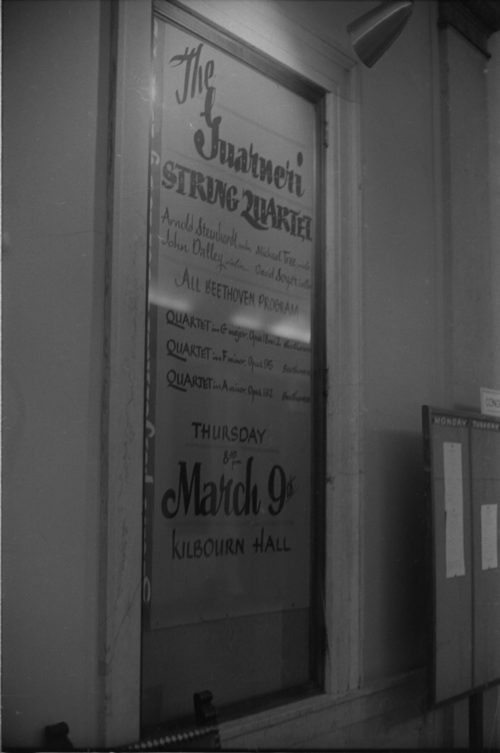
Photographer Louis Ouzer captured this delightful exchange. During intermission, members of the Guarneri Quartet share pleasantries with Professor Zvi Zeitlin (faculty member, violin, served 1967-2012) and Mrs. Zeitlin. (The group are visiting in the Director’s studio, which was located immediately across the corridor from the backstage door to Kilbourn Hall. Photographic evidence indicates that visiting artists were granted use of the Director’s studio as a green room. In the 1970s the space was re-purposed to become Schmitt Organ Recital Hall.) R1467-18,R1467-22, R1467-25, R1467-28
1972: Eastman Jazz Ensemble and Eastman Studio Orchestra on tour
► Printed program, Cincinnati, March 8th, 1972 (9 pages)
► Printed program, MENC Atlanta, March 10th, 1972 (8 pages)
► Printed program, Fisk University in Nashville, March 11th, 1972 (8 pages)
Fifty years ago this week, on or around March 7th, 1972, the Eastman Jazz Ensemble and the Eastman Studio Orchestra departed on tour with their respective directors, Chuck Mangione and Ray Wright. As I commented last week when featuring Oliver Nelson’s world premiere and guest solo appearance with the Eastman Studio Orchestra, Mr. Nelson accompanied the Eastman musicians as distinguished guest soloist in repeat performances of his own Piece for Studio Orchestra and Soloist.
The tour’s itinerary took in three destinations, with performances at Walnut Hills High School in Cincinnati, Ohio; at the Civic Center Auditorium in Atlanta, Georgia, where the Music Educators National Conference was in session; and in the Henderson A. Johnson Gymnasium on the campus of Fisk University in Nashville, Tennessee. The Eastman musicians’ performance at Fisk University was one segment of a larger program promoted under the title “Jazz: Unlimited Horizons in Music Education”. The engagement at Fisk University also included a separate workshop performance by the Eastman Jazz Ensemble. The tour’s three concert programs are displayed here, together with selected photos by Louis Ouzer, who accompanied the Eastman musicians on tour.
As noted previously, the Eastman Jazz Ensemble had first gone on tour in March, 1968 when accompanying the Eastman Wind Ensemble on a tour that included a performance at MENC in Seattle. For the Eastman Studio Orchestra, the March, 1972 tour represented that ensemble’s first tour since its founding in 1970.
► Photos by Louis Ouzer:
Photographer Louis Ouzer accompanied the Eastman musicians on their three-city tour. These shots capture ensemble members and their directors in candid moments during travel.R1450-7, R1452-3A, R1452-15A, R1452-20A, R1452-32A, R1459-15A
Shots taken either in rehearsal or in performance. The Eastman Jazz Ensemble under its director Chuck Mangione; and, the Eastman Studio Orchestra under its director Ray Wright with guest soloist Oliver Nelson. R1457-17, R1457-19, R1457-27, R1463-25A, R1465-28
1983: Status of the demolition in the neighborhood
As I’ve commented previously, in January, 1983, the City of Rochester commenced with demolition of the aged buildings standing on the city block bounded by East Avenue and Main, Gibbs, and Chestnut Streets. The end goal was to be an empty block that would be graded and seeded to await eventual redevelopment. For the Eastman School in particular, redevelopment promised a propitious future home for the Sibley Music Library, which was experiencing tremendous logistical difficulties in its Swan Street building owing to exponential growth of the collections in the post-World War II decades.
These two shots taken on March 12th, 1983 show the progress of the demolition in what was specifically referred to as “the Eastman School’s front yard”. Ground-breaking for the new building on the block would not take place until May 15th, 1987 and there would be much alliance-building, planning, negotiating, wrangling, and fundraising before that date, but demolition was the necessary beginning.
► Photos by Louis Ouzer: R3166-12A, and R3166-14A
The Weekly Dozen
In this week’s Weekly Dozen we recognize an Eastman Opera production of La Traviata that was mounted on the one hundredth anniversary of that opera’s world prmeiere; the fifth-anniversary performance of the Eastman Children’s Chorus, which flourish in the 1960s and ‘70s; a local performance of one of the mid-20th-century’s most renowned duo-piano teams; an Eastman Jazz Ensemble run-out performance (and run-outs were by now standard fare for that ensemble); and some superlative student performances such as grace the Eastman concert calendar each week of the semester.
►March 6, 1934: Max Landow, piano
►March 7, 1953: Eastman Opera Workshop presents La Traviata
►March 5 and 6, 1956: Eastman Opera Theater presents Cosi fan Tutte
►March 7, 1971: Eastman Children’s Chorus “Now We Are Five”
►March 10, 1979: Eastman Jazz Ensemble at N.A.J.E. (National Association of Jazz Educators)
►March 7, 1997: Jennifer Blyth, piano


